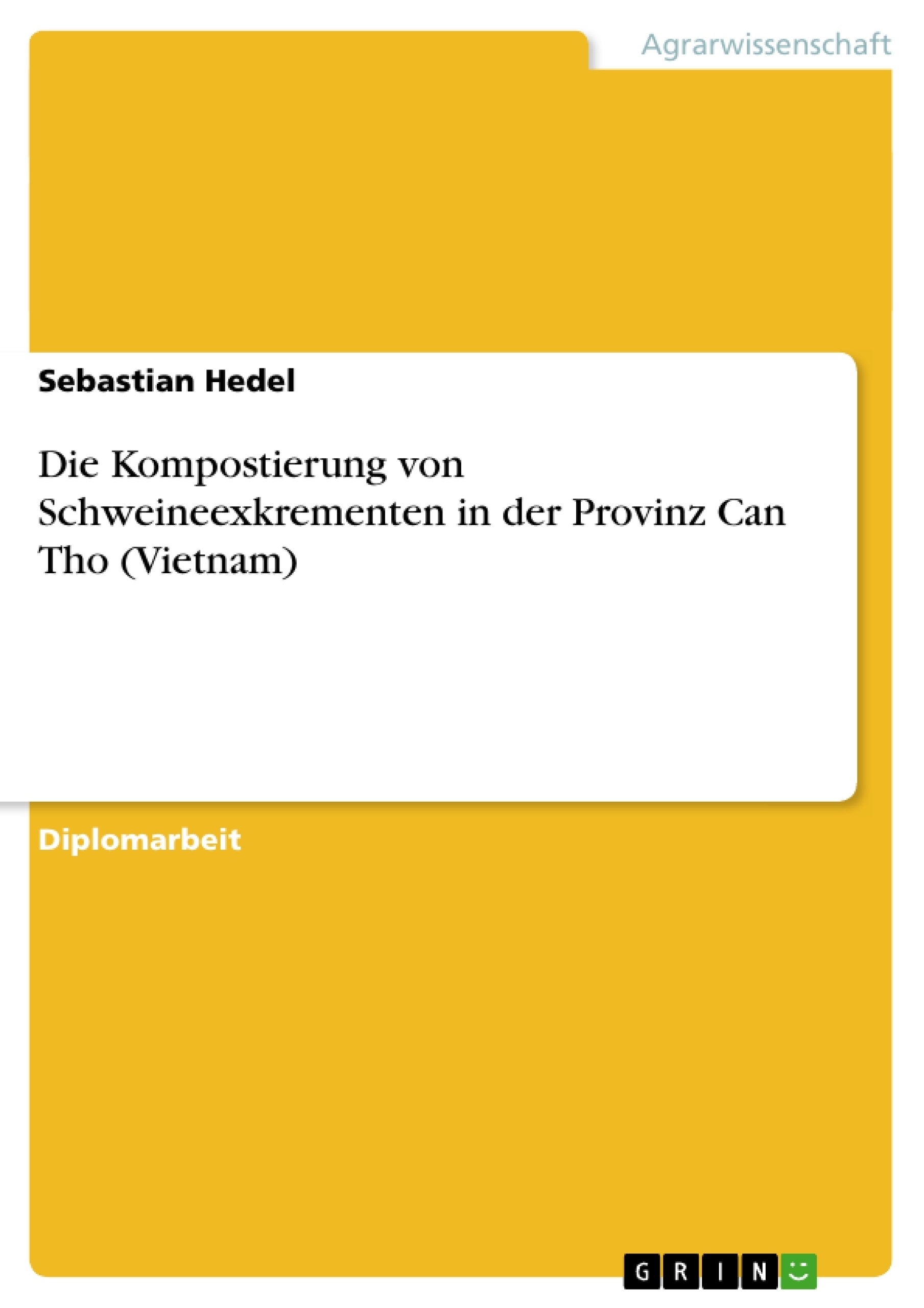Within this study, experiments were carried out in the province Can Tho (Mekong-Delta, Vietnam). Parent compost materials were pig excrements and biogas sludge of animal and human source. The goal of the work is to find out whether composting in Vietnam is possible or not and which substrates are most suitable.
Therefore, the influence of different amounts of structural material on aeration of the substrate and the suitability of the so called AAA-method (aerobic-anaeobic-treatment) were investigated.
In order to describe the rottening process, temperature profiles were obtained daily from all and water content profiles from three selected treatments. Additionally the weight, water content, organic and mineral dry matter, total carbon, total nitrogen and hygienic parameters (total coliforms and E.coli) were recorded at regular intervals. At the beginning and at the end of the treatment period, total phosphate, potassium and heavy metals (Pb, Cd, Cr, Cu, Ni and Zn) were determined.
The parameters used to evaluate the final compost products were temperature profile for adequate sanitization, respiration activity (AT4) and cress test for determination of maturity.
A temperature raise was observed in all experiments. However, none of the substrates resulted in compost that met all quality requirements.
When composting biogas sludge, the temperature rose up to a maximum of 40 °C in the centre of the compost heap, whereas up to 70 °C were reached when composting pig excrements. Organic dry matter and total carbon were reduced by up to 55 %, total nitrogen by up to 45 % of the original content. Due to the loss of mass during composting, total nitrogen content increased up to nearly 3 % in the final pig compost. This represents a relative total nitrogen accumulation of 30 %.
In all experiments the concentration of total coliforms and E.coli was reduced by several log-units. This reduction did not correlate significantly with the maximum temperature. According to Respiration Activity (AT4), all obtained composts reached maturity stage V (Rottegrad V). However, this did not correlate with the results of the cress test. It seems therefore that the CO2-Respiration alone is not a sufficient parameter to determine the stage of compost maturity.
The composting trials demonstrated that even simple rotting systems improve a substrate's handling and storage properties.
Inhaltsverzeichnis
- Einleitung
- Ausgangssituation vor Ort
- Kompostierung
- Einleitung
- Grundlagen
- Allgemein
- Temperatur
- Hygieneparameter
- Allgemein
- Escherichia Coli
- Coliforme Bakterien
- pH-Wert
- Wassergehalt
- Belüftung und Luftporenvolumen
- Umsetzung
- C/N-Verhältnis
- Biomassebildung
- Rottegrad
- Atmungsaktivität
- Kressetest
- Zusammenfassung
- Sonderformen
- Das 3A-Verfahren
- Phase I
- Phase II
- Phase III
- Vergärung
- Einfluss von Insekten
- Das 3A-Verfahren
- Material und Methoden
- Versuchsaufbau
- Aufbau des 3A-Verfahrens
- Temperaturerfassung und -summe
- Wassergehaltsbestimmung
- Probenahme
- Feuchtebestimmung
- Biogasanalyse
- Analyse der Mikroorganismen
- Reifeprüfung
- Atmungsaktivität
- Kressetest
- Ergebnisse und Diskussion
- Temperaturverlauf
- Allgemein
- Variante 1: 90 kg BGS + 2 kg RS
- Variante 2: 90 kg FTS + 4 kg RS
- Variante 3: 90 kg BGS + 4 kg RS
- Variante 4: 90 kg BGS
- Temperaturverlauf
Zielsetzung und Themenschwerpunkte
Die Diplomarbeit befasst sich mit der Kompostierung von Schweineexkrementen in der Provinz Can Tho im Mekong-Delta, Vietnam. Ziel ist es, die Eignung verschiedener Substrate für die Kompostierung zu untersuchen und zu bewerten, welche Substrate sich am besten eignen.
- Untersuchung des Einflusses von Strukturmaterial auf die Belüftung des Substrates
- Bewertung des 3A-Verfahrens (aerob-anaerob-aerob Behandlungsstufen) für die Kompostierung
- Analyse der Temperaturprofile und Wasserverteilung während der Rotte
- Bestimmung des Gehalts an organischer und mineralischer Trockensubstanz, Gesamt-Kohlenstoff, Gesamt-Stickstoff und Hygieneparameter
- Bewertung der Kompostqualität anhand von Atmungsaktivität und Kressetest
Zusammenfassung der Kapitel
Die Einleitung stellt die Ausgangssituation in der Provinz Can Tho dar und führt in die Thematik der Kompostierung von Schweineexkrementen ein. Anschließend werden die Grundlagen der Kompostierung behandelt, einschließlich der wichtigsten Parameter wie Temperatur, Hygieneparameter, pH-Wert, Wassergehalt, Belüftung, Umsetzung, C/N-Verhältnis, Biomassebildung, Rottegrad und Reifeprüfung.
Das Kapitel "Sonderformen" befasst sich mit dem 3A-Verfahren, einem speziellen Kompostierungsverfahren, und der Vergärung von Biomasse. Außerdem wird der Einfluss von Insekten auf die Kompostierung behandelt. Das Kapitel "Material und Methoden" beschreibt den Versuchsaufbau und die verwendeten Methoden zur Erfassung der relevanten Parameter.
Die Ergebnisse der Kompostierungsversuche werden im Kapitel "Ergebnisse und Diskussion" ausführlich dargestellt und interpretiert. Die Ergebnisse werden in Bezug auf die Temperaturprofile, Wassergehaltsentwicklung, Stoffumsätze, Hygieneparameter und die Reifeprüfung der Kompostprodukte analysiert und diskutiert.
Schlüsselwörter
Die Arbeit beschäftigt sich mit den Themen Kompostierung, Schweineexkremente, Biogasschlamm, Rottegrad, Temperatur, Hygieneparameter, Atmungsaktivität, Kressetest und 3A-Verfahren. Weitere Schwerpunkte liegen auf der Verbesserung der Substrateigenschaften, der Ausbringung als strukturverbesserndes Material und der Eignung für die landwirtschaftliche Nutzung.
- Quote paper
- Sebastian Hedel (Author), 2005, Die Kompostierung von Schweineexkrementen in der Provinz Can Tho (Vietnam), Munich, GRIN Verlag, https://www.grin.com/document/43001



